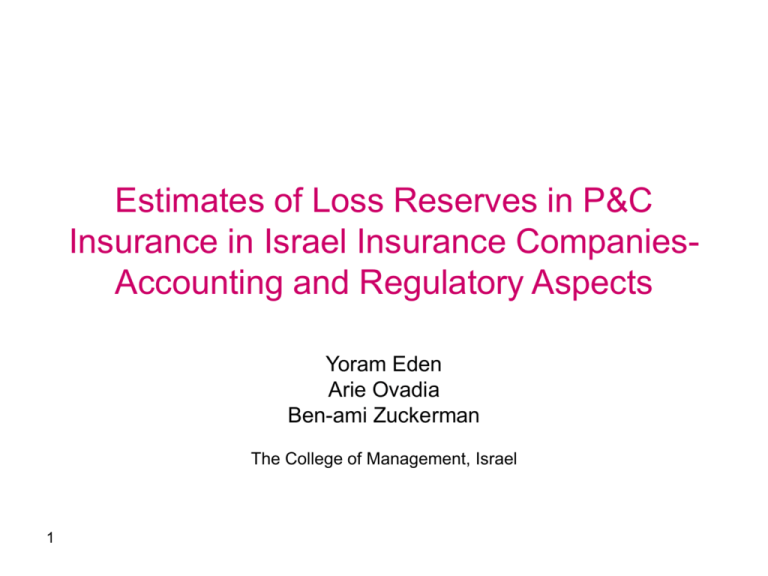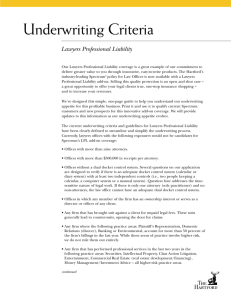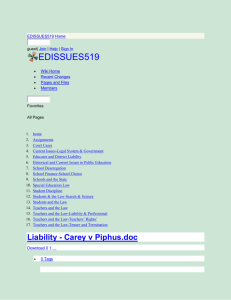The Accuracy of the Estimates of Loss Reserves in P&L Insurance of
advertisement

Estimates of Loss Reserves in P&C Insurance in Israel Insurance CompaniesAccounting and Regulatory Aspects Yoram Eden Arie Ovadia Ben-ami Zuckerman The College of Management, Israel 1 The Accounting Process of Profit Recognition in P&C Insurance • Insurance policies are usually issued for one year. • By the end of the insurance period, the premiums are fully collected (usually during the underwriting calendar year). • The premium income is reported in the underwriting year’s financial statements (after deduction of unearned premium allowance and prepaid income). 2 The Accounting Process of Profit Recognition in P&C Insurance (Cont.) • The estimation of outstanding claims (including INBR) is done on an actuarial basis (mainly chain-ladder and Bornhuetter-Ferguson methods). • Estimating the outstanding claims is particularly difficult in the “long tail” lines (e.g., Motor Act, third party liability). 3 The Long Tail Liability Lines • By the end of the underwriting year the accumulated payments out of recognized claims in these lines is only 3%-4%. By the end of the next year this ratio is still only 15% - 17%. • The premium income which is generated in the long tail lines is about 33.6% of the total premium income of the P&C insurance industry of Israel. 4 Premiums from Long Tail Liability Lines out of Total Premiums from P&C in the Israeli Insurance Industry FY 2006 FY 2005 Motor Act 21.5% 22.3% Third Party 3.0% 3.1% Employers’ Liability Other 1.8% 1.8% 7.3% 6.4% 33.6% 33.6% 5 The Profit Recognition Criteria in the “Long Tail” Lines • According to the rules imposed by the Commissioner of Insurance in Israel, the calculated profit from liability lines is added to the Loss Reserve (and not immediately recognized in the income statement), and stays there, in most cases for 3 years. • Only at the end of a period of 3 years it is released to the current year’s income statement. 6 The Profit Recognition Criteria in the “Long Tail” Liability Lines (Cont.) • For example, the insurance profit for the underwriting year 2003 is included in the Profit and Loss account of the FY 2006. • Few Insurance Companies release the deferred insurance profits only after a period of 5 years!! (I.e., the insurance profit for the underwriting year 2001 is included in the Profit and Loss account of the FY 2006). 7 The Implications of Profit Accumulation in the Liability Lines • The financial statements of insurance companies in Israel actually include a “hidden reserve”. • As Demonstrated on Tables 1&2 that “hidden reserve” (after tax) is on average about 7.7% (10.9% of the FY 2005) of the reported net equity of Israeli insurance companies, and about 10.5% (14.9% of the FY 2005) of the required STAT equity. 8 The Implications of Profit Accumulation in the Liability Lines (Cont.) • On December 31, 2006, the after-tax hidden reserve amounted to 24% of the STAT equity reported by “small” companies, and only 5% of the STAT equity of the “Big 5” insurance groups. • This accounting policy enables the insurers to postpone corporate tax payments but limits their ability to allocate cash dividends. • Hence, this profit accumulation is used as an effective regulatory mean to ascertain the capital adequacy of the Israeli insurance companies. 9 Deviation Between the Underwriting Year and the Reported Financial Year • In the liability lines there is actually a gap between the underwriting results of the reported year, and the profit from those lines included in the Profit and Loss Account. • Note also that the deferred income is increased by the investment gains of 3 years. • This deviation may deteriorate the meaning of the financial statements in periods of material fluctuations in the insurance profitability of the liability lines. 10 Deviation Between the Underwriting Year and the Reported Financial Year (Cont.) • It is not possible to learn from the financial statements about the real Loss Ratio (and the Combined Ratio) of that year in the liability lines. • Unfortunately, in many instances, analysts use wrong data. • The Management of most Insurance companies overlook this issue in their yearly MDAs. 11 STAT VS. GAAP (IFRS) • From the point of view of shareholders and the investors in general, all financial statements, including those of insurance companies should adopt GAAP. • However, the commissioner would prefer a more conservative accounting policy, in order to ascertain the financial strength of the insurance companies. 12 The Key Question • Are the reported estimates of the outstanding claims in the liability lines accurate enough to allow a yearly profit recognition? 13 Motivation for this Research • The FY 2004 was the first year in which data on the run-off of claims in previous years, and data of the accumulation of insurance profit in the Loss Reserve were partially disclosed. • That data enables us to learn about the level of accuracy of estimates of Loss Reserves in the underwriting years 2004 and 2005 in the Motor Act line (using 2006 data). 14 The Data The data included: • The “Big 5” insurance groups (which generate about 68% of the premiums in P&C insurance in Israel). • The 4 next medium-size companies. As demonstrated on tables 1&2, these 9 companies represent more than 90% of the P&C market in Israel. 15 The Data (Cont.) • The financial statements of these 9 companies include data about the run-off of the claims in the Motor Act and in the third party liability lines, starting in the underwriting year of 2001. • Since the financial statements of I.D.L (the 9th company in Israel) have been restated, we have omitted it from most of our calculations. 16 Methodology • We have compared the loss reserve estimates that were recorded in the financial statements of the FY 2004 to the discounted estimates of the loss reserve (for the same underwriting years) that were recorded in the financial statements of the years 2005 and 2006. • For each of the 8 companies, and for each year (2005, 2006), we have estimated a specific company’s discount rate reflecting the company’s average rate of return on the investments of the P&C reserves. (Note that the data of the sums accumulated in loss reserve is disclosed only on the MDA and not directly in the financial statements). 17 Methodology (Cont.) • An added result of the research is an ability to compare the rate of claims’ payments between the Motor Act line and the third party liability line. • This comparison enables us to examine whether the No-Fault regime in the Motor Act insurance does actually result in shortening the gap between the end of the underwriting year and the actual date of payment of claims. 18 Main Results (Tables 3&4) • The loss reserves estimates in the Motor Act Line recorded in the financial statements of the FY 2005 and 2006 were overstated. (This data may indicate an unexpected improvement in the insurance profitability of this line). • There is a substantial variance among the insurance companies in the level of the accuracy of the loss reserve estimations. 19 Main Results (Cont.) • This variance among the insurance companies may be explained by differences in the actuarial work. It may also indicate that some companies use loss reserve estimations as a tool for “smoothing earnings”. Noteworthy, Gaver and Paterson (JAE 2004) reported that insurance firms manage loss reserves to avoid violating the IRIS ratios. 20 Main Results (Cont.) • There is no sufficient data to make an estimate of the level of accuracy of the claims reserve in the other liability lines (including third party liability insurance). • However, as demonstrated on Table 5a and 5b there is a material underestimation (of 9.12% and 6.37% ) in the reserve for third party liability insurance included in the FY 2004 and 2005 balance sheets. 21 Main Results (Cont.) • This underestimation is partially explained by a change in the legal status of outstanding claims, caused by a revolutionary judicial decision, concerning the claims for loss of future income of accident’s victims. 22 Does the Motor Act shorten the Length of time of the Legal Process Related to Claims’ settlement? • Comparison of the length of time it takes to settle a claim in the third party liability line to the length of time in the Motor Act line, shows unequivocally that in the Motor Act line the rate of payment is faster. (66% of total claims reserve for the underwriting year 2001 was already settled by the end of FY 2006, as against only 48% in the Third Party Liability Line). 23 Does the Motor Act shorten the Length of time of the Legal Process Related to Claims’ settlement (Cont.) • One explanation is that under the Motor Act No-Fault regime, there are “institutional” agreements with hospitals, and down-payments settlements to the victims, which fasten the claim settlement (before the final judicial decision is made). 24 Conclusion • The accounting profession has adopted the principle of “Fair Value”. • IFRS 4, “Insurance Contracts”, exempts an insurer temporarily (during phase 1 of this project) from some requirements of other IFRSs. • However, it will not be possible to continue in the future (under IFRS 4 phase 2) with the accounting policy of the deferment of insurance profit for a period of 3 years. 25 Conclusion (Cont.) • It is our conclusion that there was no justification, from accounting point of view, to the delay in the recognition of the profit generated in the underwriting years of 2001 and 2002. • The Commissioner should adopt alternative means for ascertaining the financial strength of insurance companies. • A better fair disclosure in the financial statements of Israeli insurance companies, which will enable analysts (among others), to measure the Loss Ratio in every line of P&C Insurance is called for. 26





